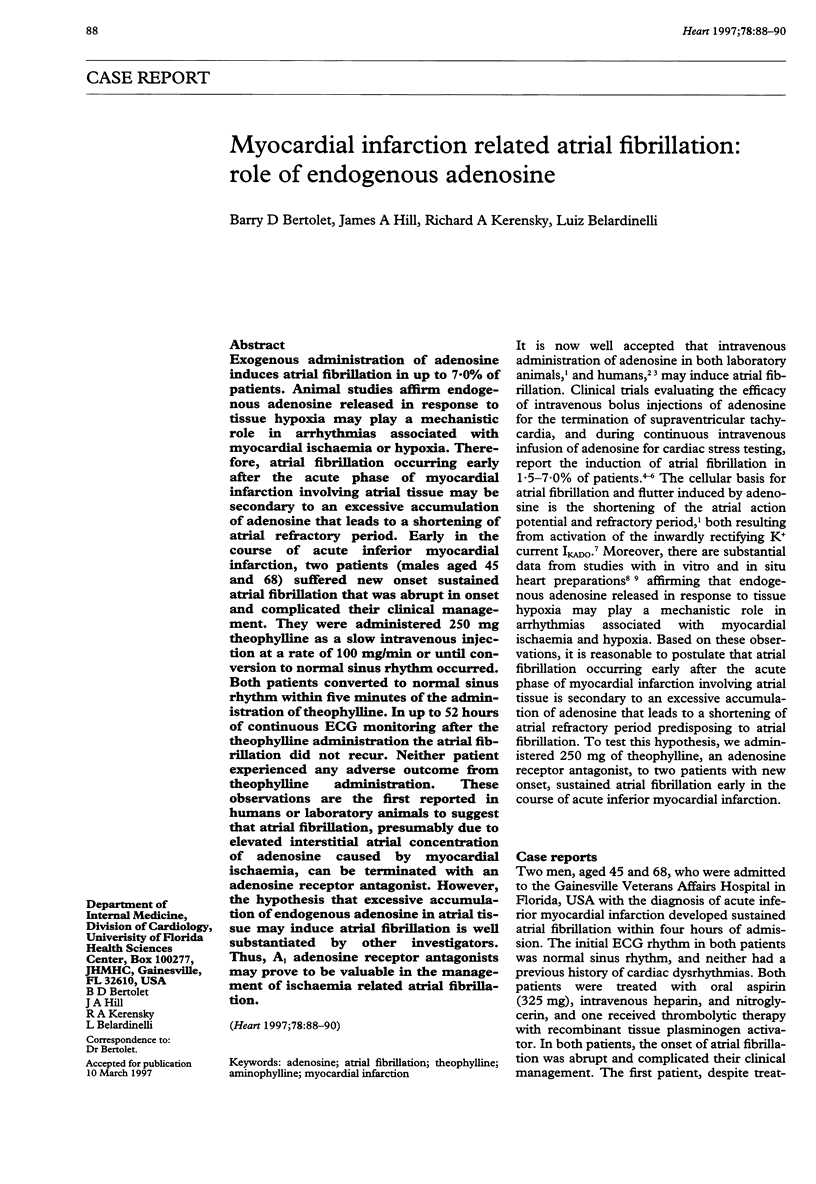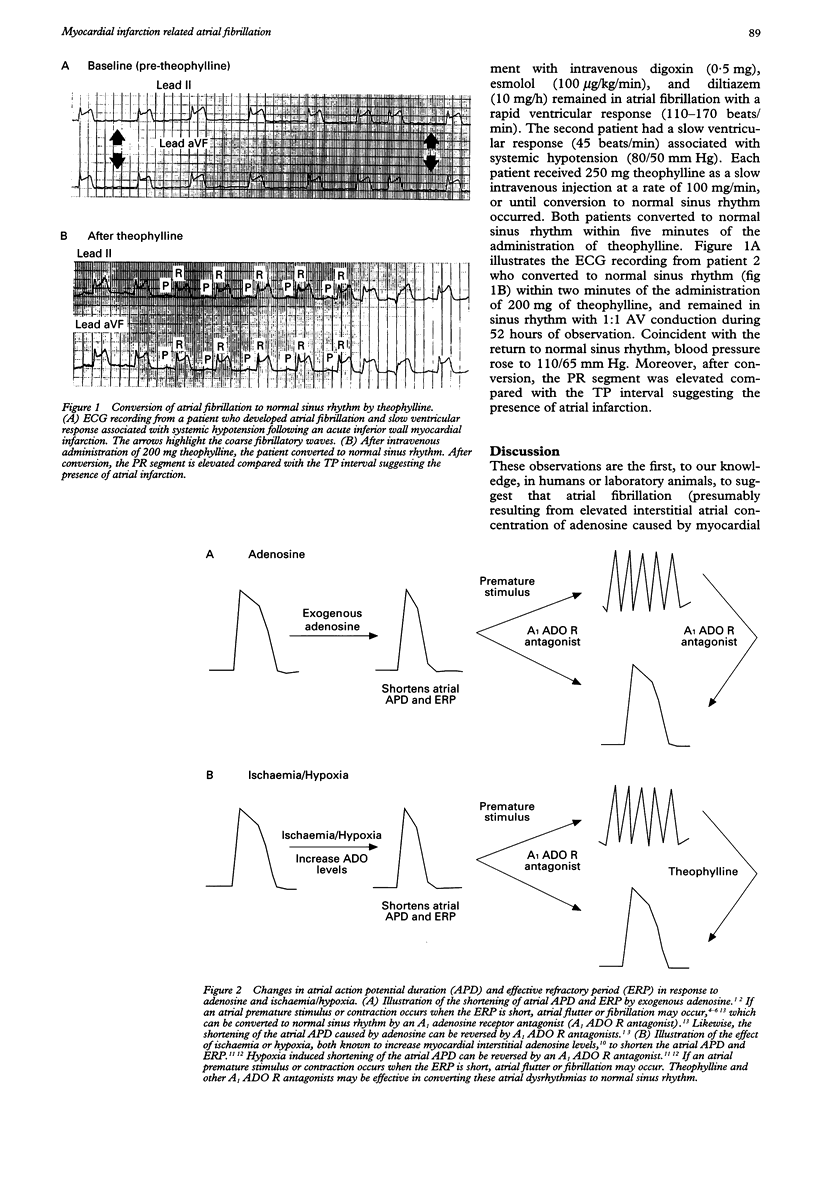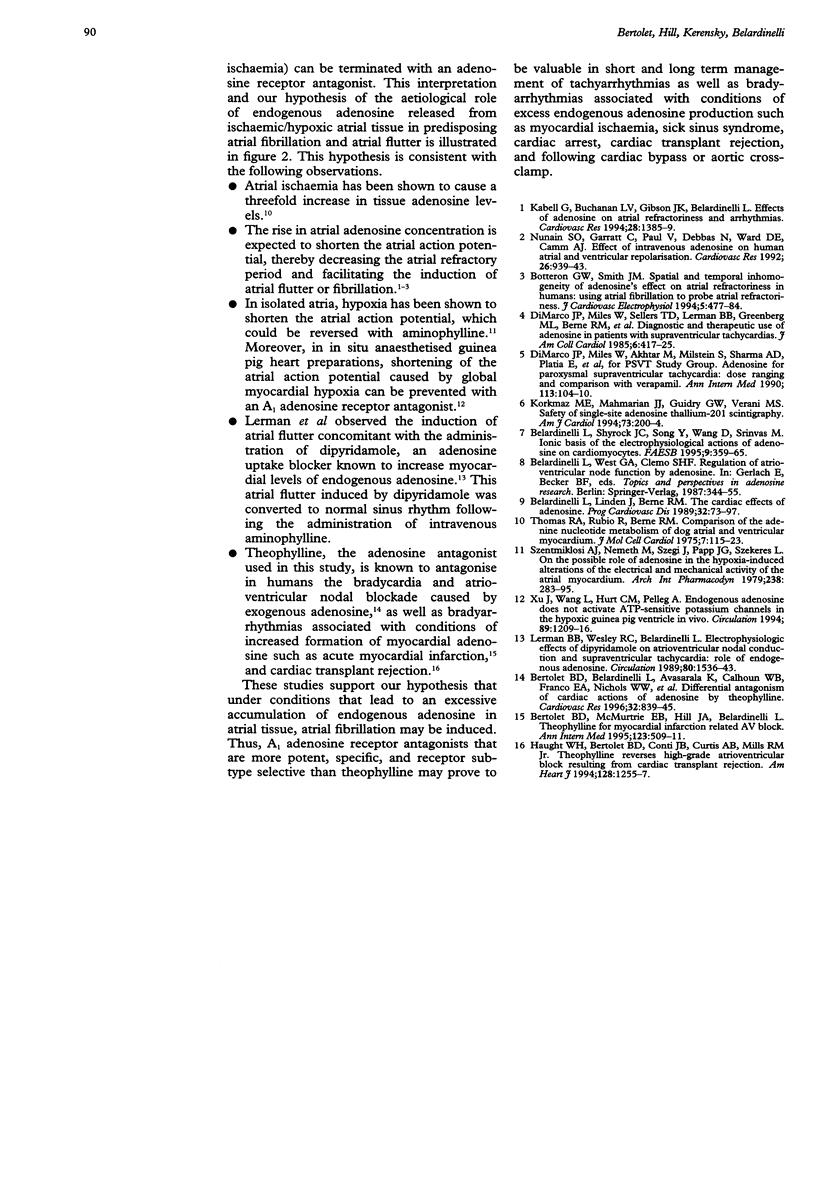Abstract
Exogenous administration of adenosine induces atrial fibrillation in up to 7.0% of patients. Animal studies affirm endogenous adenosine released in response to tissue hypoxia may play a mechanistic role in arrhythmias associated with myocardial ischaemia or hypoxia. Therefore, atrial fibrillation occurring early after the acute phase of myocardial infarction involving atrial tissue may be secondary to an excessive accumulation of adenosine that leads to a shortening of atrial refractory period. Early in the course of acute inferior myocardial infarction, two patients (males aged 45 and 68) suffered new onset sustained atrial fibrillation that was abrupt in onset and complicated their clinical management. They were administered 250 mg theophylline as a slow intravenous injection at a rate of 100 mg/min or until conversion to normal sinus rhythm occurred. Both patients converted to normal sinus rhythm within five minutes of the administration of theophylline. In up to 52 hours of continuous ECG monitoring after the theophylline administration the atrial fibrillation did not recur. Neither patient experienced any adverse outcome from theophylline administration. These observations are the first reported in humans or laboratory animals to suggest that atrial fibrillation, presumably due to elevated interstitial atrial concentration of adenosine caused by myocardial ischaemia, can be terminated with an adenosine receptor antagonist. However, the hypothesis that excessive accumulation of endogenous adenosine in atrial tissue may induce atrial fibrillation is well substantiated by other investigators. Thus, A1 adenosine receptor antagonists may prove to be valuable in the management of ischaemia related atrial fibrillation.
Full text
PDF


Selected References
These references are in PubMed. This may not be the complete list of references from this article.
- Belardinelli L., Linden J., Berne R. M. The cardiac effects of adenosine. Prog Cardiovasc Dis. 1989 Jul-Aug;32(1):73–97. doi: 10.1016/0033-0620(89)90015-7. [DOI] [PubMed] [Google Scholar]
- Belardinelli L., Shryock J. C., Song Y., Wang D., Srinivas M. Ionic basis of the electrophysiological actions of adenosine on cardiomyocytes. FASEB J. 1995 Mar;9(5):359–365. doi: 10.1096/fasebj.9.5.7896004. [DOI] [PubMed] [Google Scholar]
- Bertolet B. D., Belardinelli L., Avasarala K., Calhoun W. B., Franco E. A., Nichols W. W., Kerensky R. A., Hill J. A. Differential antagonism of cardiac actions of adenosine by theophylline. Cardiovasc Res. 1996 Nov;32(5):839–845. [PubMed] [Google Scholar]
- Bertolet B. D., McMurtrie E. B., Hill J. A., Belardinelli L. Theophylline for the treatment of atrioventricular block after myocardial infarction. Ann Intern Med. 1995 Oct 1;123(7):509–511. doi: 10.7326/0003-4819-123-7-199510010-00006. [DOI] [PubMed] [Google Scholar]
- Botteron G. W., Smith J. M. Spatial and temporal inhomogeneity of adenosine's effect on atrial refractoriness in humans: using atrial fibrillation to probe atrial refractoriness. J Cardiovasc Electrophysiol. 1994 Jun;5(6):477–484. doi: 10.1111/j.1540-8167.1994.tb01288.x. [DOI] [PubMed] [Google Scholar]
- DiMarco J. P., Miles W., Akhtar M., Milstein S., Sharma A. D., Platia E., McGovern B., Scheinman M. M., Govier W. C. Adenosine for paroxysmal supraventricular tachycardia: dose ranging and comparison with verapamil. Assessment in placebo-controlled, multicenter trials. The Adenosine for PSVT Study Group. Ann Intern Med. 1990 Jul 15;113(2):104–110. doi: 10.7326/0003-4819-113-2-104. [DOI] [PubMed] [Google Scholar]
- Haught W. H., Bertolet B. D., Conti J. B., Curtis A. B., Mills R. M., Jr Theophylline reverses high-grade atrioventricular block resulting from cardiac transplant rejection. Am Heart J. 1994 Dec;128(6 Pt 1):1255–1257. doi: 10.1016/0002-8703(94)90764-1. [DOI] [PubMed] [Google Scholar]
- Kabell G., Buchanan L. V., Gibson J. K., Belardinelli L. Effects of adenosine on atrial refractoriness and arrhythmias. Cardiovasc Res. 1994 Sep;28(9):1385–1389. doi: 10.1093/cvr/28.9.1385. [DOI] [PubMed] [Google Scholar]
- Korkmaz M. E., Mahmarian J. J., Guidry G. W., Verani M. S. Safety of single-site adenosine thallium-201 scintigraphy. Am J Cardiol. 1994 Jan 15;73(2):200–204. doi: 10.1016/0002-9149(94)90215-1. [DOI] [PubMed] [Google Scholar]
- Lerman B. B., Wesley R. C., Belardinelli L. Electrophysiologic effects of dipyridamole on atrioventricular nodal conduction and supraventricular tachycardia. Role of endogenous adenosine. Circulation. 1989 Dec;80(6):1536–1543. doi: 10.1161/01.cir.80.6.1536. [DOI] [PubMed] [Google Scholar]
- Nunain S. O., Garratt C., Paul V., Debbas N., Ward D. E., Camm A. J. Effect of intravenous adenosine on human atrial and ventricular repolarisation. Cardiovasc Res. 1992 Oct;26(10):939–943. doi: 10.1093/cvr/26.10.939. [DOI] [PubMed] [Google Scholar]
- Szentmiklósi A. J., Németh M., Szegi J., Papp J. G., Szekeres L. On the possible role of adenosine in the hypoxia-induced alterations of the electrical and mechanical activity of the atrial myocardium. Arch Int Pharmacodyn Ther. 1979 Apr;238(2):283–295. [PubMed] [Google Scholar]
- Thomas R. A., Rubio R., Berne R. M. Comparison of the adenine nucleotide metabolism of dog atrial and ventricular myocardium. J Mol Cell Cardiol. 1975 Feb;7(2):115–123. doi: 10.1016/0022-2828(75)90013-9. [DOI] [PubMed] [Google Scholar]
- Xu J., Wang L., Hurt C. M., Pelleg A. Endogenous adenosine does not activate ATP-sensitive potassium channels in the hypoxic guinea pig ventricle in vivo. Circulation. 1994 Mar;89(3):1209–1216. doi: 10.1161/01.cir.89.3.1209. [DOI] [PubMed] [Google Scholar]
- diMarco J. P., Sellers T. D., Lerman B. B., Greenberg M. L., Berne R. M., Belardinelli L. Diagnostic and therapeutic use of adenosine in patients with supraventricular tachyarrhythmias. J Am Coll Cardiol. 1985 Aug;6(2):417–425. doi: 10.1016/s0735-1097(85)80181-9. [DOI] [PubMed] [Google Scholar]


